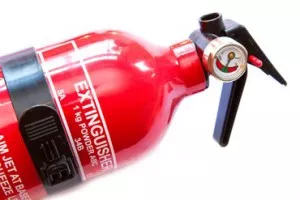
You might already have a fire safety plan, but fire is one situation where an ounce of prevention is definitely worth a pound of cure.
Unfortunately, most homeowners focus their fire prevention strategies on what to do inside the home, such as not leaving lit candles or cigarettes laying around. Garage fire safety is often overlooked, even though it is extremely important
Here is what you need to know about common garage fire safety risks, and how to prevent them.
What Makes the Garage So Unsafe?
There are many fire hazards hiding in your garage that you might not even have thought of. These include:
- Combustible materials and flammable liquids or gases like propane cylinders, solvents, varnish, and paint thinner
- Wood scraps, paper, plastic wrappings, sawdust and other accumulated debris are just waiting for a spark to turn them into tinder
- Flammable activities such as welding often create sparks
- Oil‑soaked rags can burst into flame
- Oil and gas can drip unnoticed from cars
- Electrical wiring often consists of bare bulbs hanging from cords that can get twisted or caught
- Workshops may contain built in heat sources such as water heaters or furnaces that can ignite a fire.
Why You Don’t Want a Fire in Your Garage
The garage adds value to your home and obviously you don’t want it damaged, or for your stored possessions to go up in flames – not to mention your car. But there’s another compelling reason to avoid a garage fire: chances are, it will be detected less quickly than a fire that starts in your home. By the time a garage fire is noticed, it can be raging out of control, and can quickly engulf surroundings. Going from a spark in the garage to an explosion in your house isn’t as far a distance as you might think, especially with the wrong wind conditions.
How to Prevent a Fire in the Garage
Here are the top garage fire safety tips you need:
- Store a fire extinguisher on the garage wall, within easy reach, and know how to use it
- Exercise caution around heat sources like wood‑burning stoves
- Don’t overload circuits in the garage by using multiple power tools at once
- Keep the garage door open when using combustibles such as varnish or spray paint
- Store combustible fluids in locked cabinet away from heat sources. Each substance should be in its own sealed, clearly labelled container
- Sweep the floor regularly to remove sawdust and debris, and dispose of the refuse as soon as you’re done
- Rinse and dispose of oily rags to prevent combustion; do not launder them
- Unplug and properly store heat‑producing tools after use
- Make sure there is a smoke alarm in the garage and replace the batteries regularly
- Store propane cylinders outdoors, not in the garage
- Clean up spills as soon as they occur
- Use light bulbs that do not exceed maximum wattage
- Never smoke in the garage
- If a door connects the garage to your living space, it should be self‑closing, without a pet door installed through which flames or toxic gases could spread
- Install a sprinkler system
Following these tips should keep your family safe, yet if the right combination of fuel, oxygen and heat comes together, a fire could still occur. That’s where your existing fire plan comes in handy. Have those emergency contact numbers and insurance information on hand, just in case.
It’s also important that you also keep your garage door in peak working condition so that it doesn’t become a fire risk from a malfunctioning opener, or an inoperable door. At Baker Door Company, we offer 24 hour emergency garage door service, to help diagnose and repair!








Add new comment